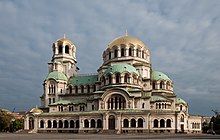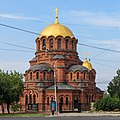Byzantine Revival architecture

The Byzantine Revival (also referred to as Neo-Byzantine) was an architectural revival movement, most frequently seen in religious, institutional and public buildings. It incorporates elements of the Byzantine style associated with Eastern and Orthodox Christian architecture dating from the 5th through 11th centuries, notably that of Constantinople (present-day Istanbul) and the Exarchate of Ravenna. Neo-Byzantine architecture emerged in the 1840s in Western Europe and peaked in the last quarter of the 19th century in the Russian Empire, and later Bulgaria. The Neo-Byzantine school was active in Yugoslavia between World War I and World War II.
List by country[]
German states[]

Earliest examples of emerging Byzantine-Romanesque architecture include the Alexander Nevsky Memorial Church, Potsdam, by Russian architect Vasily Stasov, and the Abbey of Saint Boniface, laid down by Ludwig I of Bavaria in 1835 and completed in 1840. The basilica followed the rules of 6th-century Ravenna architecture, although its corinthian order was a clear deviation from the historical Byzantine art. In 1876 Ludwig II of Bavaria commissioned Neo-Byzantine interiors of the externally Romanesque Neuschwanstein Castle, complete with mosaic images of Justinian I and Greek saints.
Danish architect Theophil Hansen became a supporter of the style in the 1850s. His major works belonged to the Neo-Grec and Neo-Renaissance style, however, Hansen as a professor of Byzantine art in the Academy of Fine Arts in Vienna shaped a generation of architects that popularized Neo-Byzantine architecture in Austro-Hungary, Serbia and post-war Yugoslavia. Hansen's own Neo-Byzantine work includes the Arsenal in Vienna (1852—1856, with Ludwig Förster), the Holy Trinity Greek Orthodox Church, Vienna (1856—1858) and the Christuskirche in , Vienna (1858—1860).
Several Neo-Byzantine-style churches were constructed during the Gründerzeit, for instance, the Sacred Heart Church or the Rosary Basilica, both located in Berlin.
Serbia[]
Serbia's modern sacral architecture got its main impetus from the dynastic burial church in Oplenac which was commissioned by the Karađorđeviċ dynasty 1909.[1] With the arrival of Russian émigré artists after the October Revolution, Belgrade's main governmental edifices were planned by eminent Russian architects trained in Russia. It was King Aleksandar I. who was the patron of the neobyzantine mouvement.[2] Its main proponents were , Momir Korunović, , and (Никола́й Петро́вич Красно́в). Their main contribution were the royal castles on Dedinje, the Church of Saint Sava, St. Marks church (Belgrade). After the communist era ended and Nebojša Popović were proponents of new tendencies in sacral architecture which used classic examples in the Byzantine tradition.[3]
Russian Empire[]
Sophia Cathedral in Pushkin (1782–1788) was the earliest and isolated experiment with Byzantine treatment of otherwise neoclassical structures. In 1830s Nicholas I of Russia promoted the so-called Russo-Byzantine style of churches designed by Konstantin Thon. Nicholas I despised true Byzantine art; Thon's style in fact had little common with it. Notably, Thon routinely replaced the circular Byzantine arch with a keel-shaped gable, and the hemispherical Byzantine dome with an onion dome; layout and structural scheme of his churches clearly belonged to neoclassical standard.
True Byzantine art, popularized by Grigory Gagarin and David Grimm, was adopted by Alexander II of Russia as the de facto official style of the Orthodox Church. Byzantine architecture became a vehicle of Orthodox expansion on the frontiers of Empire (Congress Poland, Crimea, the Caucasus). However, few buildings were completed in the reign of Alexander II due to financial troubles. Alexander III changed state preference in favor of Russian Revival trend based on 16th-17th century Moscow and Yaroslavl tradition, yet Byzantine architecture remained a common choice, especially for large cathedrals. Neo-Byzantine cathedrals concentrated in the western provinces (Poland, Lithuania), the Army bases in Caucasus and Central Asia, the Cossack hosts and the industrial region in Urals around the city of Perm. Architects David Grimm and Vasily Kosyakov developed a unique national type of a single-dome Byzantine cathedral with four symmetrical pendentive apses that became de facto standard in 1880s-1890s.
The reign of Nicholas II was notable for the architect's turn from this standard back to Hagia Sophia legacy, peaking in the Naval Cathedral in Kronstadt and Poti cathedral. These designs employed reinforced concrete that allowed very fast construction schedule; their interiors contained clear references to contemporary Art Nouveau yet the exteriors were a clear homage to medieval Constantinople. Russian Neo-Byzantine tradition was terminated by the revolution of 1917 but was continued by emigrant architects in Yugoslavia and Harbin.

Naval Cathedral, Kronstadt
The Kazan church, Novodevichy Cemetery, St. Petersburg
Ioannovsky Convent, St. Petersburg
St. Nicholas Monastery, Verkhoturye

New Athos Monastery, New Afon

Nativity Cathedral, Riga

St. Michael the Archangel Church, Kaunas

The Orthodox Church in Białowieża
United States[]
In the United States and elsewhere, the Neo-Byzantine style is often seen in vernacular amalgamations with other Medieval revivalist styles such as Romanesque and Gothic, or even with the Mission Revival or Spanish Colonial Revival styles.
Notable American examples include many buildings on the campus of Rice University in Texas, and Christ Church United Methodist in Manhattan by Ralph Adams Cram; Immaculate Conception Church in New Orleans, St. Francis de Sales Church in Philadelphia, Cathedral Basilica of St. Louis,and Saints Peter & Paul Orthodox Church, Buffalo, New York.
Basilica of the National Shrine of the Immaculate Conception[]
The Basilica of the National Shrine of the Immaculate Conception is a large Catholic minor basilica and national shrine located in Washington, D.C., United States of America. The shrine is the largest Catholic church in the United States and in North America, and the tallest habitable building in Washington, D.C.Its construction of Neo-Byzantine architecture began on September 23, 1920, with renowned contractor John McShain and was completed on December 8, 2017, with the dedication and solemn blessing of the Trinity Dome mosaic.
Great Britain and Ireland[]
Westminster Cathedral (1895–1903), the Catholic cathedral in London, is the largest and most thorough British effort in the style, by John Francis Bentley (1839–1902), but there are a number of other churches and other buildings such as the Christ Church, Brixton Road, also in London, by Arthur Beresford Pite, 1897–1903, near the Oval Cricket Ground and St Mary and St George Church, High Wycombe, (1935-1938). From about 1850 to 1880 in Bristol a related style known as Bristol Byzantine was popular for industrial buildings which combined elements of the Byzantine style with Moorish architecture. Newman University Church, Dublin (1885–86) is a notable Irish example.
Gallery[]

The Neo-Byzantine façade of Westminster Cathedral, London
Alexander Nevsky Church, Ganja, Azerbaijan

Painting of the Neuschwanstein Castle Throne Room

Interior of the Sacred Heart Church (Berlin)

Cathedral Basilica of St. Louis, St. Louis, Missouri

Basilica of the National Shrine of the Immaculate Conception in Washington D.C.

Church of Saint Sava, Belgrade, Serbia

Interior of the Church of Saint Sava

Interior of the Rosary Basilica (Berlin)

Oplenac Church-mausoleum, Topola, Serbia

St. Mark's Church, Belgrade, Serbia
Christ Church United Methodist, New York City

A historic photochrom print of the Fontaine Guillaume, which literally translates to "William (Wilhelm) Fountain"

Interior of Church of Our Lady Seat of Wisdom, Dublin
See also[]
- Romanian Revival architecture – combines Byzantine Revival with Art Nouveau and others
References[]
- ^ Aleksandar Kadijević: Byzantine architecture as inspiration for serbian new age architects. Katalog der SANU anlässlich des Byzantinologischen Weltkongresses 2016 und der Begleitausstellung in der Galerie der Wissenschaften und Technik in der Serbischen Akademie der Wissenschaften und Künste. Serbian Committee for Byzantine Studies, Belgrade 2016, ISBN 978-86-7025-694-1, S. 87.
- ^ Aleksandar Kadijević: Byzantine architecture as inspiration for serbian new age architects. Katalog der SANU anlässlich des Byzantinologischen Weltkongresses 2016 und der Begleitausstellung in der Galerie der Wissenschaften und Technik in der Serbischen Akademie der Wissenschaften und Künste. Serbian Committee for Byzantine Studies, Belgrade 2016, ISBN 978-86-7025-694-1, S. 62.
- ^ Aleksandar Kadijević 2016: Between Artistic Nostalgia and Civilisational Utopia: Byzantine Reminiscences in Serbian Architecture of the 20th Century. Lidija Merenik, Vladimir Simić, Igor Borozan (Hrsg.) 2016: IMAGINING THE PAST THE RECEPTION OF THE MIDDLE AGES IN SERBIAN ART FROM THE 18TH TO THE 21ST CENTURY. Ljubomir Maksimovic & Jelena Trivan (Hrsg.) 2016: BYZANTINE HERITAGE AND SERBIAN ART I–III. The Serbian National Committee of Byzantine Studies, P.E. Službeni glasnik, Institute for Byzantine Studies, Serbian Academy of Sciences and Arts. Hier S. 177 (Academia:PDF)
External links[]
| Wikimedia Commons has media related to Neo-Byzantine architecture. |
- Byzantine Revival architecture
- 19th-century architecture
- 20th-century architecture
- Byzantine architecture
- Revival architectural styles











































